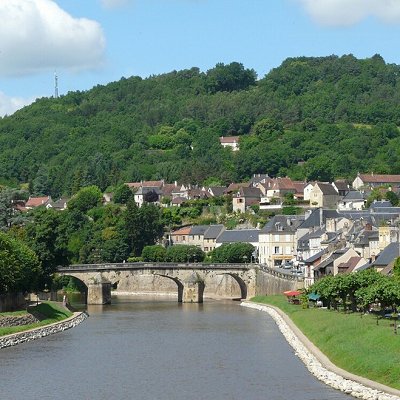
Like us on Facebook
PLACE NAMES


 
|
|
Montignac
|

|
|
Montignac, also called Montignac sur Vézère or Montignac-Lascaux, is a commune in the Dordogne department in Nouvelle-Aquitaine in southwestern France. It is a small town situated on the Vézère river and has been the capital of the canton of Montignac since 1790. In 2015 it became the capital of the newly created Canton de la Vallée de l'Homme. The poet Pierre Lachambeaudie (1806-1872) was born in the village.
Montignac is a commune and small town in the department of Dordogne. It is situated in the historic region of Périgord Noir, just below the confluence of the River Vézère and the Laurence, a small river which rises near the town of Thenon. Montignac is 11 km (7 mi) southeast of Thenon, 13 km (8 mi) southwest of Terrasson-Lavilledieu, and 19 km (12 mi) north of Sarlat-la-Canéda. The D704 district road from Brive-la-Gaillarde passes through the town where it intersects with the D65, D704e and D706. The area of the commune is 3,715 hectares. The highest point is in the northwest and the lowest point in the southwest where the Vézère leaves the commune.
Montignac is the main centre for visiting the prehistoric sites in the Vézère valley. The modern part of the town to the south of the river has several hotels and the tourist office. To the north of the river lies the old town, where there are a maze of streets with fourteenth- to sixteenth-century timbered houses. A market is held here twice weekly and there are restaurants where visitors can sit beside the river under medieval timbered beams.
Montignac has a historic bridge, from which fireworks are launched on holidays such as Bastille Day and during the summer festival of world folklore and dance, which is held annually in July.
The main attraction of the region is the Lascaux Cave, actually a complex of caves containing Upper Paleolithic painted art discovered in 1940 and estimated to be 17,300 years old. The cave was put on show in 1948, but it was found that the paintings were being damaged by the carbon dioxide exhaled by visitors, and in 1963, the cave was closed to the public. A replica cave, known as Lascaux II, was opened nearby in 1983, so that visitors could still experience the paintings without damaging the originals. Since 2016 a larger and more accurate replica is displayed in Lascaux IV Centre International de l'Art Pariétal built by Snøhetta in Montignac. In 1979, Lascaux was added to the UNESCO World Heritage Sites list along with other prehistoric sites in the Vézère valley.
 Feel free to Email me any additions or corrections Feel free to Email me any additions or corrections
LINKS AVAILABLE TO YOUR SITE
| | |





